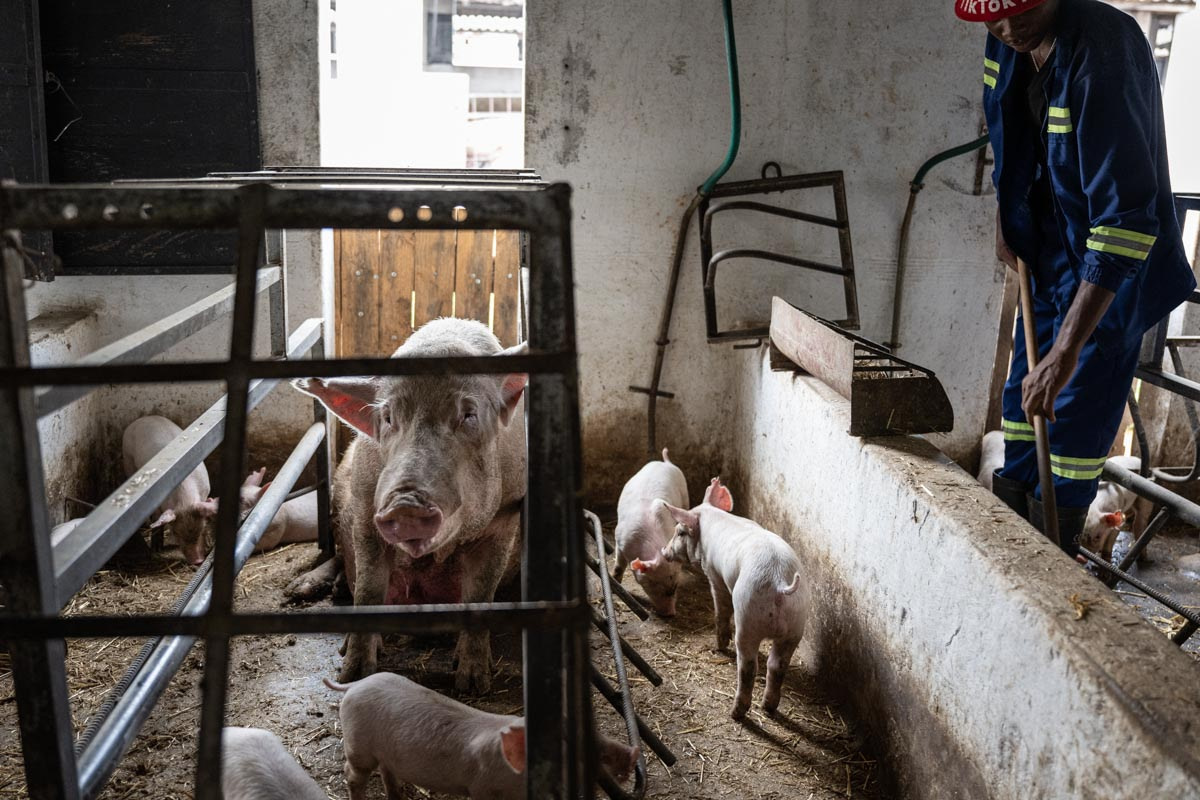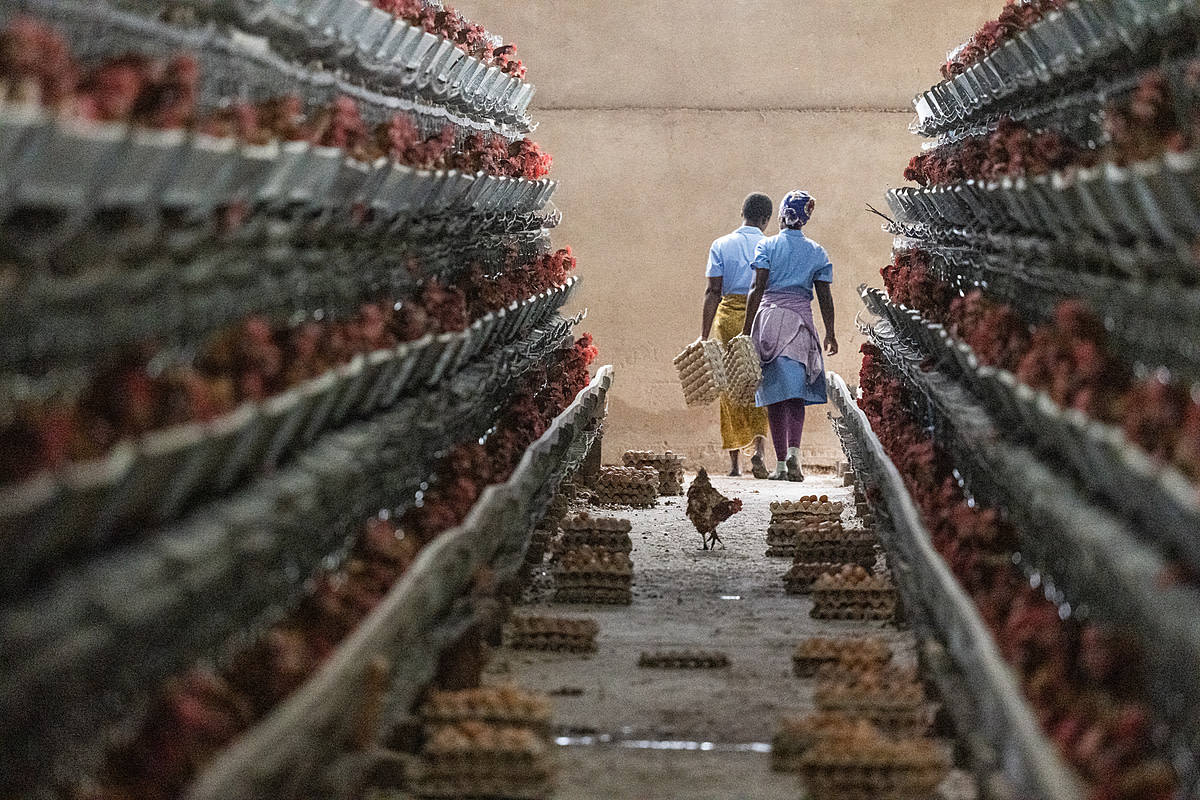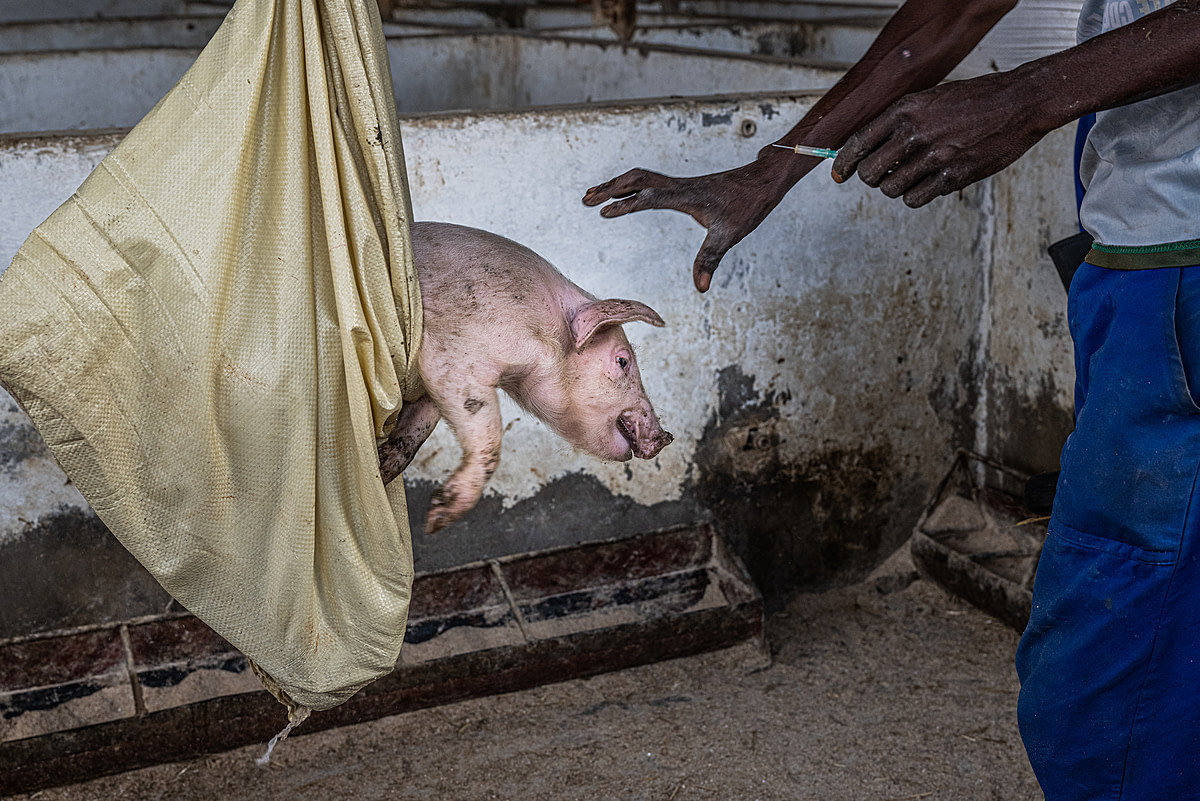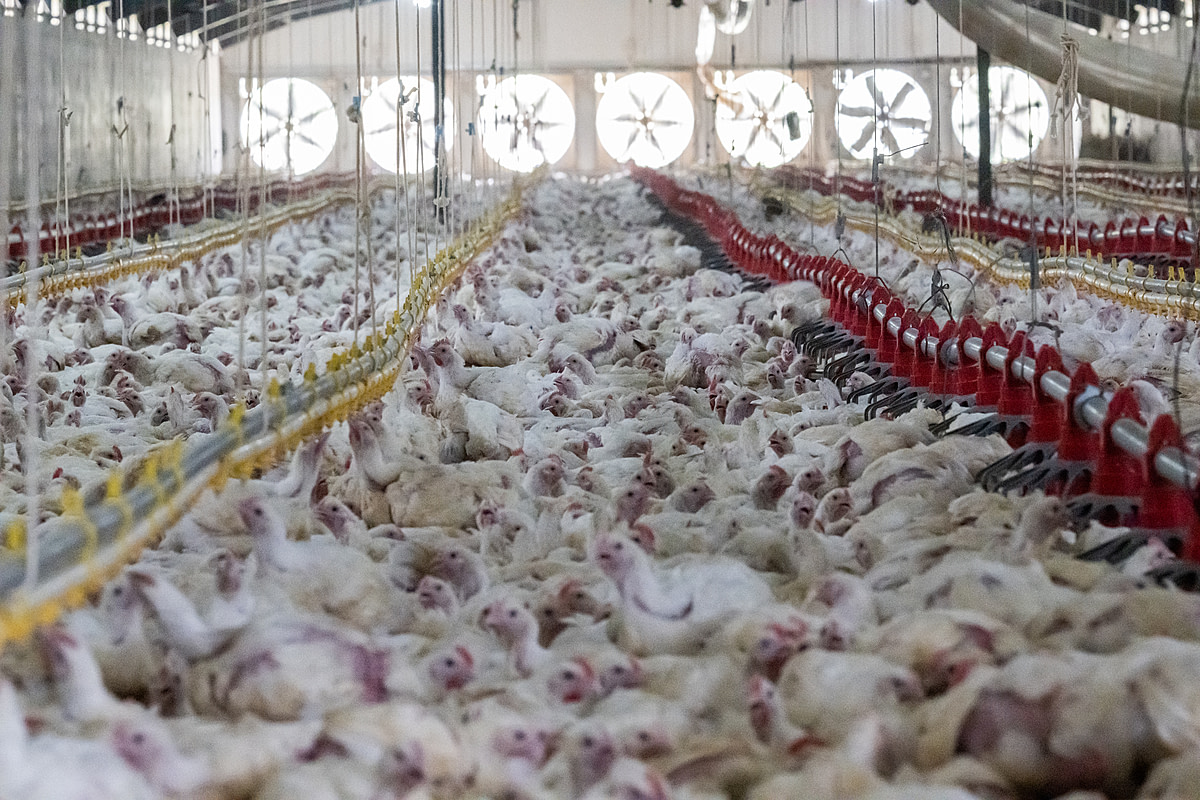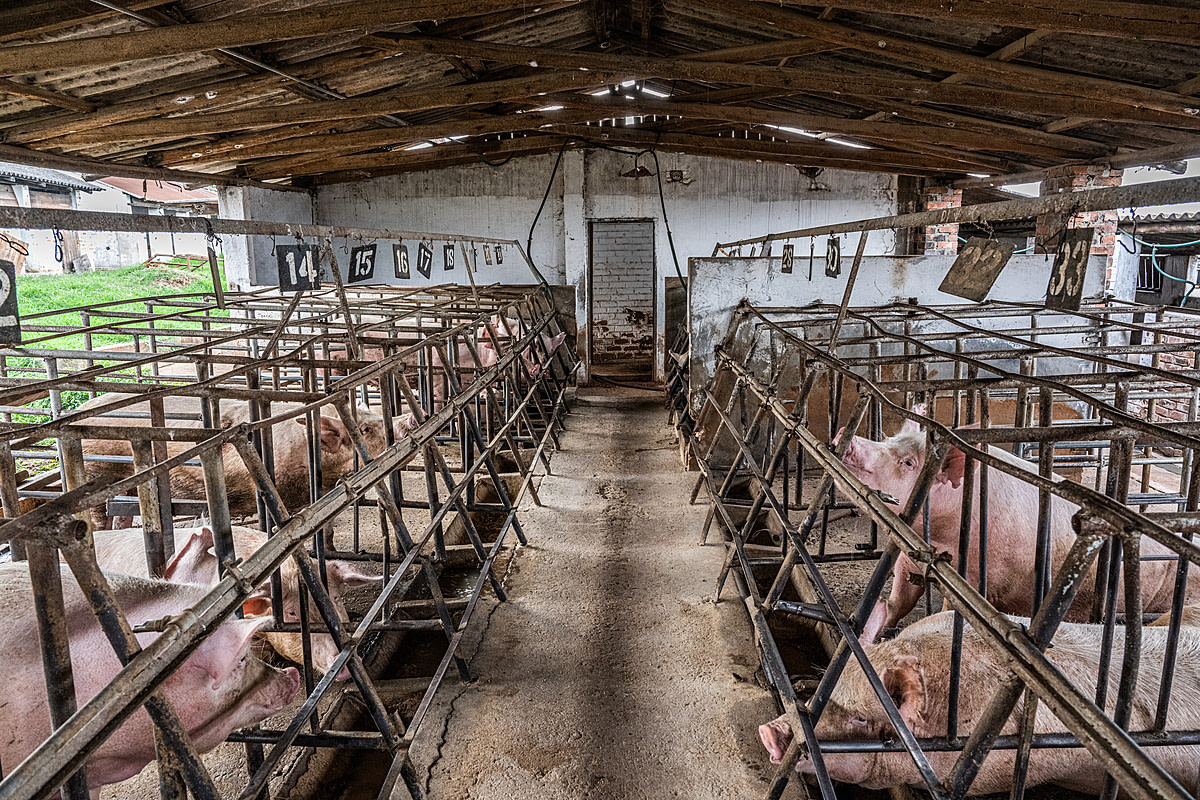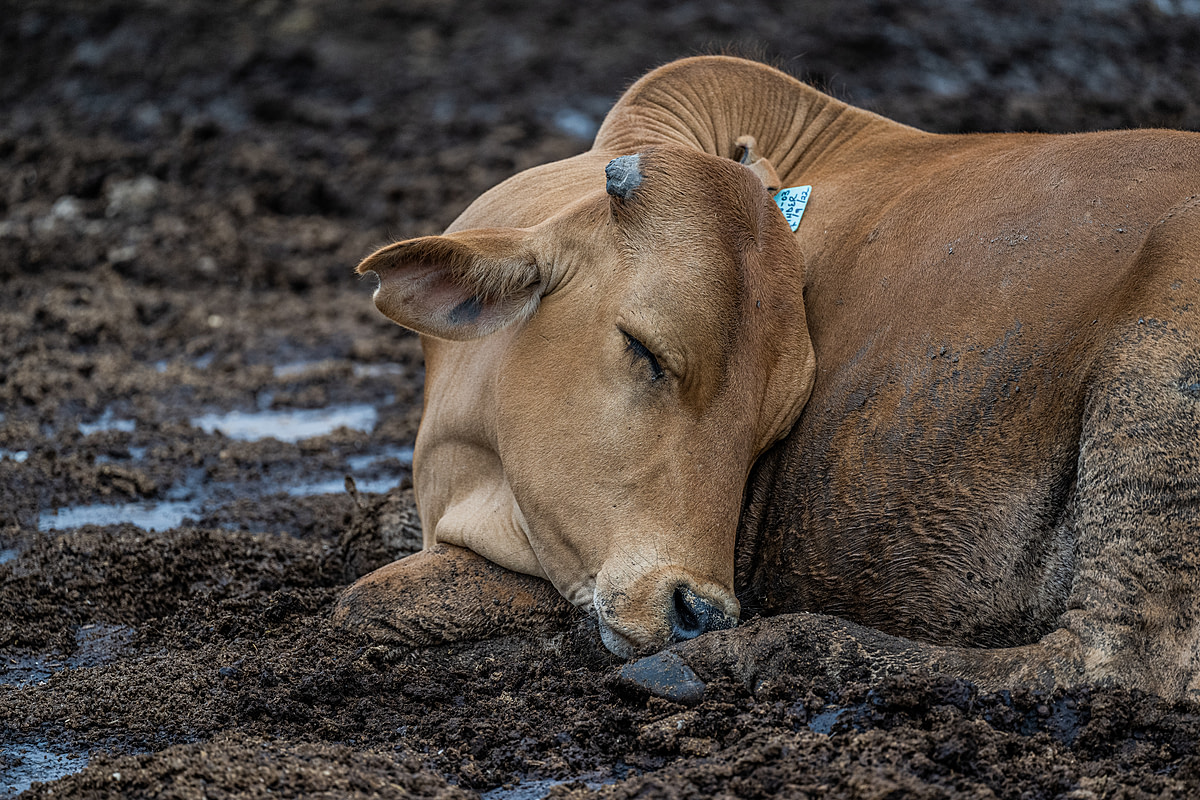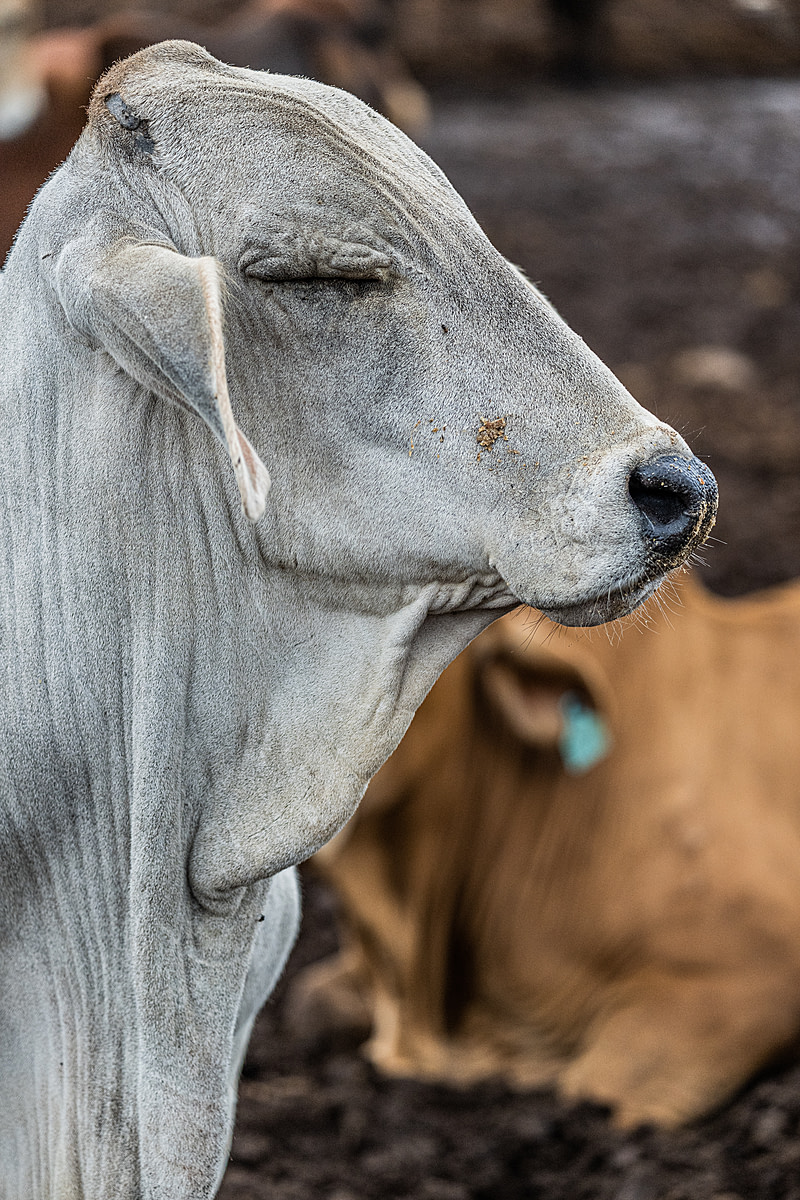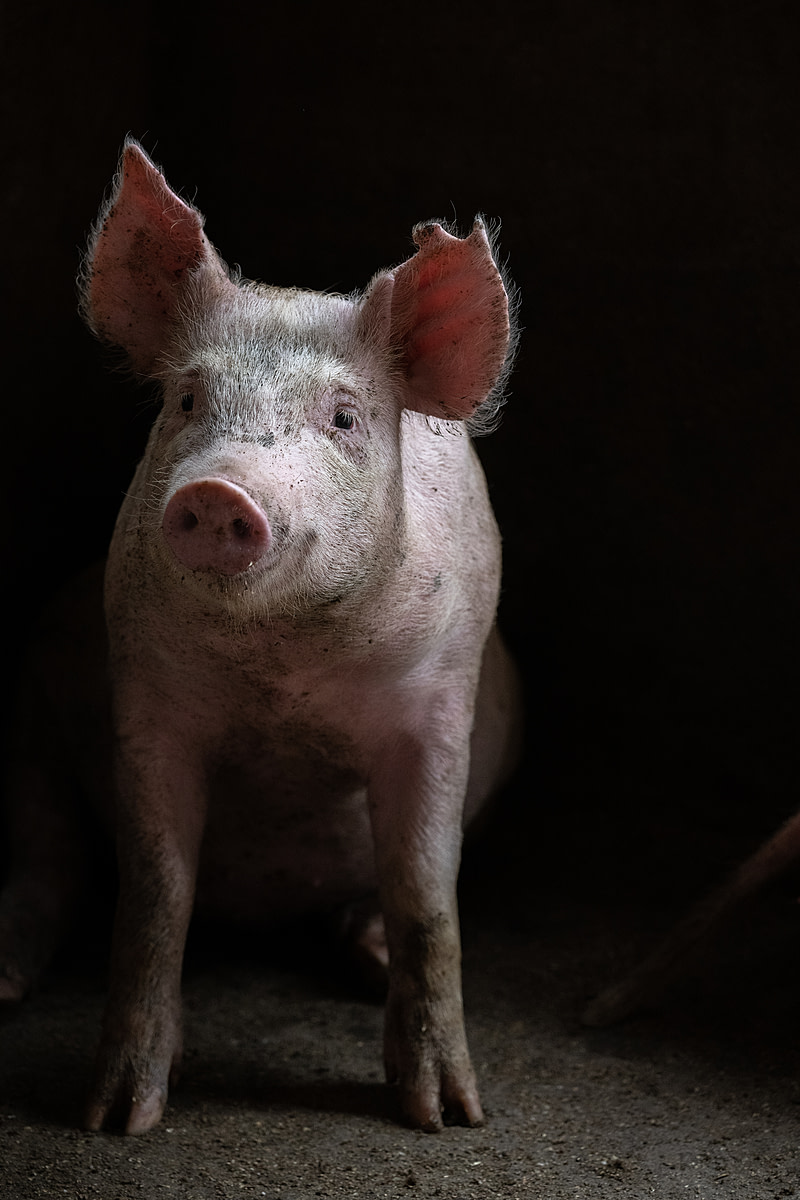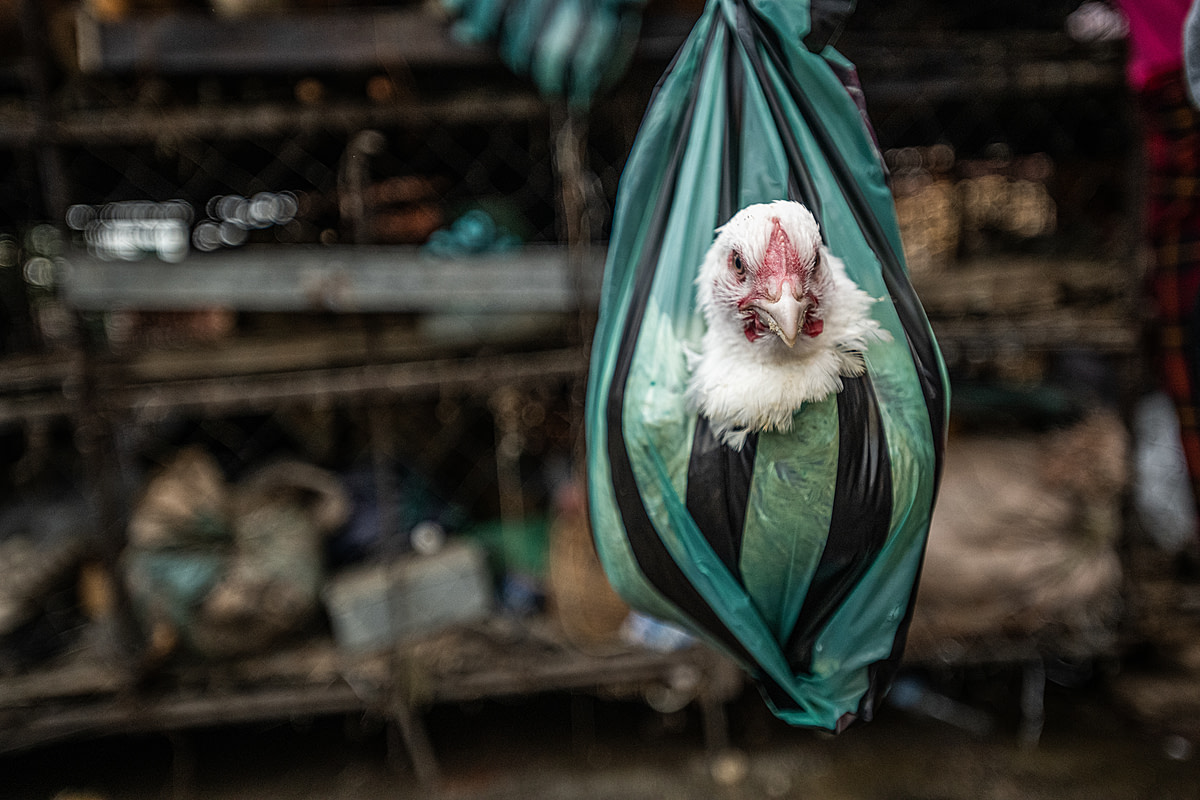On an intensive pig farm, a sow sits in a farrowing crate with her piglets nearby as a worker cleans the neighbouring pen. Sub-Saharan Africa, 2022.
Jo-Anne McArthur / Sibanye Trust / We Animals
[Content warning: Contains confronting images and/or video footage]
In late 2022, We Animals Founder Jo-Anne McArthur visited sub-Saharan Africa in collaboration with the African not-for-profit organization Sibanye Trust to investigate the growth of industrial animal farming in the region. Here she shares her account from her time in the field.
Photographer: Jo-Anne McArthur
From small farms holding a few hundred pigs in barren pens to cramped sheds holding 24,000 birds in each, I came home with visuals that show a diversity of how people and companies are keeping animals. I spoke with farmers about the trends in farming, and they all pointed toward intensification. “It’s not very kind for the birds,” a hen farmer explained, “but people don’t have purchasing power so eggs must be produced as cheaply as possible.”
Workers at an industrial egg production farm collect eggs from hens housed in battery cages. Each cage is intended to hold up to three hens, but four or five hens per cage were often visible. Each barn on this farm holds 24,000 hens. Sub-Saharan Africa, 2022.
Jo-Anne McArthur / Sibanye Trust / We Animals
Workers at an industrial egg production farm collect eggs from hens housed in battery cages. Each cage is intended to hold up to three hens, but four or five hens per cage were often visible. Each barn on this farm holds 24,000 hens. Sub-Saharan Africa, 2022.
Jo-Anne McArthur / Sibanye Trust / We Animals
A farm worker fills large food dispensers with feed in a crowded barn holding 1,200 visibly balding floor-raised hens used for egg production. Chaos ensues as the birds clamber and crowd around him to eat. Sub-Saharan Africa, 2022.
Jo-Anne McArthur / Sibanye Trust / We Animals
I refer to “sub-Saharan Africa” – yes, a large territory! I’m choosing to withhold country names until we know it’s safe for me and our NGO partner to specify our whereabouts. For now, it is still not, but that is a story for another time.
The industrial farming of animals is on the rise on the African continent, and this is mobilizing animal and environmental advocacy organizations. The photos and videos of this worrisome trend that I created alongside my African colleagues will serve to help campaigners, educators and legislators to address the problem of a trend that could be stopped or reversed before it is entrenched, as it is in the west.
Piglets sleep huddled together in a heap at the back of a pen on a large industrial farm. Nearby, their mother gazes into the camera from inside a farrowing crate. Sub-Saharan Africa, 2022.
Jo-Anne McArthur / Sibanye Trust / We Animals
Thirty-three thousand chickens raised for meat live tightly packed together, cramped inside a massive shed on an industrial broiler chicken farm. The farm has slated these 33-day-old chickens to be rounded up for slaughter that evening. Sub-Saharan Africa, 2022.
Jo-Anne McArthur / Sibanye Trust / We Animals
This is no easy feat in countries where eating more meat indicates a rise in upward mobility. More meat is associated with better health and prosperity. “Vegetarianism is laughable here,” said a colleague, in explaining that western campaigners are seeking to impose this solution, while African animal advocates are meeting society where it’s at. “This is why we are beginning with welfare campaigns, and raising awareness about farmed animal sentience.” Another campaigner countered the sentiment about vegetarianism’s status, saying that plant-based eating is on the rise in cities like Cape Town and Nairobi, and that the work ahead involves making sure that countries such as Chad, Mali, Sierra Leone and Senegal, in which plant-rich eating is the norm, remain that way. We kept a busy schedule of farm visits, and I returned home with pictures of caged hen facilities, floor-raised hen farms, broiler chicken farms, pig farms both small and large, fish farms and backyard animal projects that included ducks, turkeys, goats and rabbits. We visited farms owned by massive national companies: some had a hundred animals, while others had thousands. In some cases I was not granted permission to shoot, but conversations with farm managers still took place. “The future of pig farming is bright,” one young manager proclaimed after a farm tour in which the pigs were kept packed into filthy concrete pens.
Two rows of sows, encrusted with filth, live in bare concrete-floored gestation crates inside an intensive pig farm barn. The sows can only stand, sit, and lie down in these small crates. They cannot move forward, backward or turn around. Sub-Saharan Africa, 2022.
Jo-Anne McArthur / Sibanye Trust / We Animals
It was evident that large farms were following the trends of the Global North. Broiler chicken farming systems and practices, for example, look virtually identical to me in Africa, Australia and North America. The way birds are collected by hand late at night is the same. Feed is the same, though farmers in Africa buy and make their own more locally. At an animal feeding operation we visited, where cows are fattened for beef, farmers grow maize in the surrounding fields to feed their cattle.
A bull calf sleeps in a mixture of wet mud and feces inside a cattle fattening yard, also known as an Animal Feeding Operation (AFO). Penned bulls, steers, and oxen live here for approximately 90 days, where they are intensively fed and gain about 300 kilograms of weight before the yard sends them to slaughter. The animals live in their own filth, sleeping in groups amid mud and feces, which in some places is knee-deep, and they have no shelter from the elements. Sub-Saharan Africa, 2022.
Jo-Anne McArthur / Sibanye Trust / We Animals
Male cattle sleep in groups in mud and feces at a fattening yard, also known as an Animal Feeding Operation (AFO). Penned bulls, steers, and oxen live here for approximately 90 days, where they are intensively fed and gain about 300 kilograms of weight before the yard sends them to slaughter. The animals live in their own filth, which in some places is knee-deep, and they have no shelter from the elements. Sub-Saharan Africa, 2022.
Jo-Anne McArthur / Sibanye Trust / We Animals
A portrait of a white steer living inside a cattle fattening yard, also known as an Animal Feeding Operation (AFO). Penned bulls, steers, and oxen live here for approximately 90 days, where they are intensively fed and gain about 300 kilograms of weight before the yard sends them to slaughter. The animals live in their own filth, which in some places is knee-deep, and they have no shelter from the elements. Sub-Saharan Africa, 2022.
Jo-Anne McArthur / Sibanye Trust / We Animals
As with the farms I and our other photojournalists have visited globally, we’ve seen that the animals inside have nothing to do and little to live for. Hormones and the stress of confinement lead to fights, injuries and death. One pig farm did have enrichment for the animals crowded into pens: a solitary plastic burlap-style sack hanging from the ceiling into the middle of the room, dangling just above snout height so that they would have to work to gain purchase. The sacks were worn, and I wondered whether that was due to the pigs’ successes or if they’d simply weathered over time. Unlike farms I’ve visited in other countries, many of the pens here were open-air, with walls four or five feet high. The pigs were sold to slaughter at either 23 weeks of age, or 70 kg, “whichever came first,” we were told by a farm hand who escorted us around the property.
A young pig stares curiously from beneath a frayed plastic burlap-style sack hanging from the ceiling of their pen on a large industrial farm. The bag is given to the pigs for psychological enrichment. Sub-Saharan Africa, 2022.
Jo-Anne McArthur / Sibanye Trust / We Animals
Dead hens pulled from their cages lie on the floor of an industrial egg production farm. Above them, sixty-week-old hens live crowded inside stacked rows of battery cages at an industrial farm, where they are kept for two years to lay eggs. Hens die prematurely from illness or injury from other birds while living in close confinement. Sub-Saharan Africa, 2022.
Jo-Anne McArthur / Sibanye Trust / We Animals
Similar to farms I have visited globally, animals are seen and treated as commodities here. Death on farms (before they are sent to slaughter) is an inevitable part of life. Veterinary care is expensive and therefore prohibitive. If animals can’t fight an infection or injury, they die. That’s it.
With my NGO colleagues, I also visited a busy live animal market in the heart of the city’s most dangerous township. We didn’t stay long, just long enough to capture photos of thirsty, despondent birds. A woman purchased a chicken, and I was allowed to photograph her having her legs tied together and then put in a plastic bag. They made a hole for her head to poke through. A far cry from the barns of 24,000 birds I visited earlier, yet nonetheless symbolic of the attitudes that African advocates are working hard to shift.
A market vendor at a crowded live animal market in Africa holds a purchased chicken by her wings and whose legs are tied together with copper wire. The chicken will be placed inside a plastic bag for the customer to take her away alive and kill her at home. Sub-Saharan Africa, 2022.
Jo-Anne McArthur / Sibanye Trust / We Animals
A purchased chicken looks out from inside a plastic bag at a crowded live animal market in Africa. Her legs have been tied with copper wire, and the customer will use the plastic bag to take her home alive. She will be killed at the customer’s home. Sub-Saharan Africa, 2022.
Jo-Anne McArthur / Sibanye Trust / We Animals
These photos offer a glimpse into the lives and deaths of animals on farms, and give us a sense of the work ahead.
These photos offer a glimpse into the lives and deaths of animals on farms, and give us a sense of the work ahead.























Sub-Saharan Africa, 2022.
Jo-Anne McArthur / Sibanye Trust / We Animals
Editor's Note:
Our work in this region was only possible because of African advocates who work on behalf of animals across Africa. While these visuals depict a specific region, animal exploitation is a global issue taking place in every country.
Photographer: Jo-Anne McArthur
We’d like to express our thanks to our friends at the public policy action tank Brighter Green for connecting WAM to our African partners, Sibanye Trust.
Explore and download more visuals from this collection via our stock platform.

